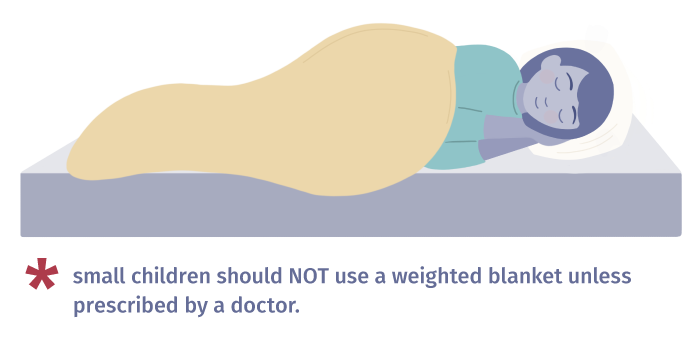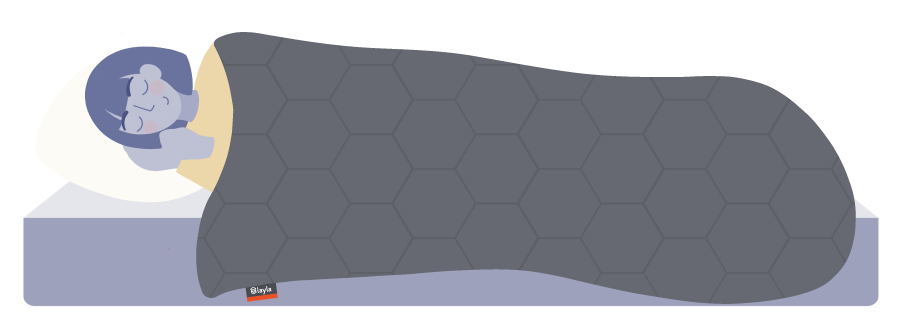Weighted blankets have become more and more popular in recent years. The heavy bedding is similar to a comforter, but instead of containing fluffy down or synthetic fibers, it is filled with glass beads, poly pellets, or another weighted material. Most companies advertise that this added weight can help people relax, improve their sleep, and even reduce anxiety and depression.
Well, I wanted to know if they really work; as a person who struggles with sleep apnea and anxiety, I was interested to see if a weighted blanket could help me sleep more deeply and feel better both mentally and physically.
This video was made in partnership with Layla, who sent me their new weighted blanket to use – I tried it for three nights and our readers can see below how it worked for me!
My Three Day Test
I tried out a Layla weighted blanket for three whole nights – I didn’t know exactly what to expect – would a big, heavy blanket really help me sleep?
Well, here is what happened over those three nights.
- Night One. At first, I felt strange under my weighted blanket. It felt heavy and somewhat cumbersome. After I fell asleep, I found myself quickly awakened. I think this is because, as I tried to move around in my sleep, the blanket held me back. When this happened, I would wake up. By the morning, I can say that I did not feel more rested.
- Night Two. On the second night, I still had some trouble sleeping. However, I did not wake up nearly as much. I woke up a few times when I tried to move around, but I did wake up feeling a little better.
- Night Three. I did not wake up at all the entire night. I finally felt the Layla weighted blanket doing its job. I woke up feeling refreshed and, judging by the lines in my face, I don’t think I moved around all night. I can also say that my mood and demeanor where much improved. I am not a morning person but, on this morning, I felt very low anxiety.
Overall, the Layla weighted blanket provided the right amount of weight for me and also featured nice weight distribution. I felt a consistent amount of weight across my entire body. Also, just speaking of feel, the fleece side of the cover was cozy and added another level of comfort.
How Do Weighted Blankets Work?
So, the Layla weighted blanket worked for me. I slept better and woke up feeling great. So, what is really happening here? What is this extra weight actually doing?
Well, let’s talk about the science of it all.
Weighted blankets could have a soothing effect on sleepers because of something called Deep Touch Pressure; this is the deep pressure one feels when being held, hugged, or swaddled. Occupational therapist Karen Moore told Psychology Today, “These blankets work by providing input to the deep pressure touch receptors throughout the body. Deep pressure touch helps the body relax. Like a firm hug, weighted blankets help us feel secure, grounded, and safe.”
Studies have found that Deep Touch Pressure leads to an increase in serotonin, a neurotransmitter associated with feelings of happiness and well-being. Also, in these same studies, researchers have witnessed that Deep Touch Pressure may lead to a decrease in cortisol, a hormone that’s released under stress. As serotonin levels rise and cortisol levels fall, we could sleep more soundly.
RELATED: Neural Link Between Poor Sleep Quality and Depression
Based on the benefits of Deep Touch Pressure, some studies have explored the connection between weighted blankets and better sleep quality.
During one study, the subjects didn’t sleep better, but they still liked the feeling of the weighted blanket. However, another study found that, out of a cohort of insomniacs, four out of fives slept longer, more deeply, and with fewer nighttime wakeups when they used a weighted blanket.
Some researchers have also studied the effects weighted blankets might have on conditions such as ADHD and anxiety. Children with ADHD slept more soundly with a weighted blanket and also had fewer disturbances in school. In another study, 63 percent of subjects reported lower anxiety after using a weighted blanket.
While weighted blankets might help with a variety of issues, there are some people who should be careful:
- Small children should not use a weighted blanket unless prescribed by a doctor.
- Elderly sleepers should make sure they are able to move the weighted blanket without extreme effort.
- Those who struggle with circulatory problems or claustrophobia could have issues as well.
As a general rule, it’s a good idea to consult with a physician before starting to use a weighted blanket.
What Should People Consider When Purchasing?
Say someone has decided a weighted blanket is worth trying out. Now, they need to think about a few things if they want to find the right weighted blanket for them:
- Size and weight. As with most bedding, there is no one weighted blanket for everyone. This is especially true with weighted blankets because the weight of one’s bedding should be decided by body weight. Most producers recommend that people choose a blanket that is 10 percent of their weight plus a few pounds. So, if someone weighs 150 lb, a weighted blanket of 15, 16 or 17 lb should be a good match for them.
- The size of the bed. When it comes to size, people don’t choose a weighted blanket to fit their bed. Instead, they should choose one to fit their size. People also don’t want overhang, because this can cause the weighted blanket to slowly fall off the bed. Layla offers a Twin, Queen, and King-size blanket with no real overhang.
- Sleep temperature. When someone is looking at a weighted blanket, they should also think about what temperature at which they like to sleep. Some weighted blankets are woven with breathable materials such as cotton, and others are woven with polyester. If someone chooses a polyester blanket, it could be a stuffy sleeping experience; just think about temperature preferences and sleeping environment.
- Weighted blanket protection. A weighted blanket can be placed inside a cover, just like a pillow in a pillowcase. Some weighted blankets even come with a cover included. Whether it comes with a cover on not, look for snaps or tabs on the weighted blanket. These are useful in securing the weighted blanket within a cover. Also, think about how the cover will affect the feel and temperature of the weighted blanket.
- The filling. When it comes to choosing the weighted blanket filling, people have two main options: glass beads or poly-pellets, which are small pieces of plastic. The two have different textures: The glass beads are smooth and sand-like, and the poly-pellets are like small stones. If someone wants a lower-profile weighted blanket, the glass beads could work for them. If they like a thicker blanket with a more bumpy feeling, the poly-pellets should be the way to go.
Those who think a weighted blanket could be helpful to them should keep these criteria in mind. With the right weighted blanket, we could all find ourselves enjoying calmer, deeper sleep.


